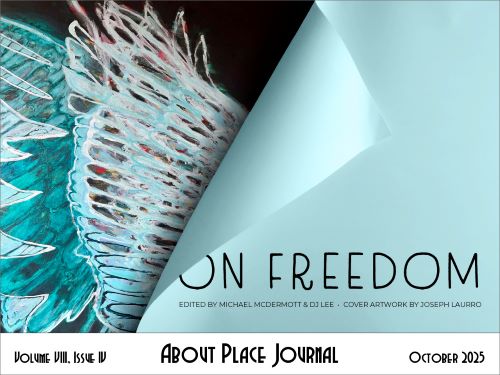Selected by David Shapiro for the National Poetry Series, Sarah O’Brien’s debut book of poetry appears at first glance to be an extended meditation on photography. The collection is divided into seven sections, with each one made up of lyric poems investigating what it means to see something – to capture a moment, even if it’s blurred.
Selected by David Shapiro for the National Poetry Series, Sarah O’Brien’s debut book of poetry appears at first glance to be an extended meditation on photography. The collection is divided into seven sections, with each one made up of lyric poems investigating what it means to see something – to capture a moment, even if it’s blurred.
The book opens with two epigraphs: one from W.G. Sebald’s The Emigrants which is about a man whose face and hands turned blue (or developed) due to silver poisoning, and the other from a tour brochure of Indonesia which says, “The Beauty of an Object Lies in The Beautiful Heart.” The opening poem describes a city painted white with the white rubbing off on the hands of the people. Simply titled “One” and placed outside of the seven titled sections, the poem, combined with the epigraphs, sets the tone and hints at what is to come: a keen eye able to look with wonder at the world and capture it in all its strangeness and beauty.
Throughout the collection, O’Brien is attempting to do what the title orders: catch light. While “catching light” is an explanation of what a camera does, it is also here what the poet is doing. In “Light Matters,” she writes, “Memory is in light.” Memories, in light, can be captured in photographs, just as they can be captured in poetry.
Formally, the poems vary in length and style from prose poems to lineated poems with lines that cascade across the page. Regardless of the form, the language is tightly controlled without a single word wasted. This restraint adds to the feeling of removal that exists in these poems. The speaker is separated from the subject as if by an apparatus, but there are wonderfully surprising moments when suddenly the speaker forgets her role as woman-behind-the-lens, like in “Five Eyes.” The first four sections of the poem discuss eyes, from doll eyes to glass eyes to Darwin’s description of elephants shedding “abundant tears in situations / of pain and sorrow” (which the speaker notes has sadly been disproven). In the fifth section, the poem opens suddenly just as it ends:
To eye. A change in weather or the quality of a painted-on iris. As it comes
closer it is less distinct.
Skin, water, the sun overhead until you can’t look at it. Letters
read into a sea. In low or intense light
all detail is lost in perceiving the sheer. Light travels and picks up
every particle on the way and illuminates it. You see the air moving, like that.
There must be distance, he said,
for the thing to be seen. So I hold you out in front of me and say now –
let me look at you.
That gesture of holding someone – a long lost friend, a distant relative – out at arm’s length to have a look is something so human, familiar, and warm. Yet there is a duality to the image, that to really see something, distance is required, so once again the speaker is slightly removed, and perhaps what is at arm’s length is not a friendly face, but a photograph, a book, an object.
It becomes increasingly clear throughout the collection, that this isn’t only about capturing a moment on film. Moments are also captured in words, and they are captured in memories, no matter how brief or confused those may be.
The third section, “Captions” plays with the fluidity of memory, as it matches poem captions up with blank boxes, much like Brandon Shimoda does with his series “The Headmaidens and Bridesmen” in The Alps. The boxes slow the reader down and forces him or her to really focus on the image and imagine what should exist inside. The images being described change over time from new knowledge being learned (“once / you’re told it’s a name, you read it, you can read the water now”) to the speaker noticing new details (“And a slight blur in the background, a bird you didn’t even notice taking off”).
In brief language, O’Brien masterfully re-creates scenes that feel familiar, that feel like photos I’ve seen before with light-erased faces and roads stretching outside the frame. There is a magical quality to them, as the imagined photograph captures a swimmer whose hand, while pulling himself out of the water, “rests exactly on the surface of a lake.” Another “photo” has frozen time, with its subject caught forever walking in a field and “[a] storm permanently poised on the edge.” Even though time has passed since the image was taken, what exists inside the photo is always happening in the present tense. Another caption wonders “what is that seeing called” when you see something clearly but only for a split second, and the final poem in the “Captions” series explains why the box above is empty: “Weather is abstract until it touches the skin. There is talk of snow beginning, of that instant that has never been captured on film.”
“Optical Toys,” the second section, has a playful quality to it as it is made up of poems mimicking the toy they are named for. “Kaleidoscope” uses anaphora for its form – the pieces repeating but creating something new with each turn. In “Stuttersight,” O’Brien writes, “Here is a beginning without an end and even though you’d like to, you can’t see it any other way.” “Zoetrope” imagines the repeated image: “A whole herd of horses, or one.” These optical toys, often associated with childhood, are excellent tools for O’Brien to dissect the world with.
This is a strong debut, and it makes sense that Shapiro, who is also an art critic, would be drawn to this collection. The book is compact and makes for a quick read, but the poems are rich and invite multiple readings as they open up in various ways with each new seeing.




